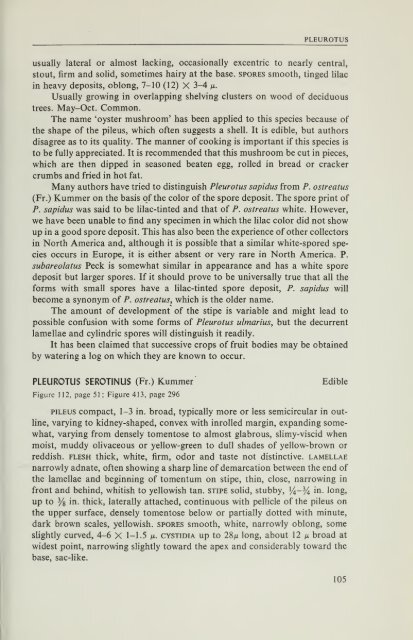You also want an ePaper? Increase the reach of your titles
YUMPU automatically turns print PDFs into web optimized ePapers that Google loves.
PLEUROTUS<br />
usually lateral or almost lacking, occasionally excentric to nearly central,<br />
stout, firm and solid, sometimes hairy at the base, spores smooth, tinged lilac<br />
in heavy deposits, oblong, 7-10 (12) X 3-4 jjl.<br />
Usually growing in overlapping shelving clusters on wood of deciduous<br />
trees. May-Oct. Common.<br />
The name 'oyster mushroom' has been applied to this species because of<br />
the shape of the pileus, which often suggests a shell. It is edible, but authors<br />
disagree as to its quahty. The manner of cooking is important if this species is<br />
to be fully appreciated. It is recommended that this mushroom be cut in pieces,<br />
which are then dipped in seasoned beaten egg, rolled in bread or cracker<br />
crumbs and fried in hot fat.<br />
Many authors have tried to distinguish Pleurotus sapidus from P. ostreatus<br />
(Fr.) Kummer on the basis of the color of the spore deposit. The spore print of<br />
P. sapidus was said to be hlac-tinted and that of P. ostreatus white. However,<br />
we have been unable to find any specimen in which the lilac color did not show<br />
up in a good spore deposit. This has also been the experience of other collectors<br />
in North America and, although it is possible that a similar white-spored spe-<br />
cies occurs in Europe, it is either absent or very rare in North America. P.<br />
subareolatus Peck is somewhat similar in appearance and has a white spore<br />
deposit but larger spores. If it should prove to be universally true that all the<br />
forms with small spores have a Hlac-tinted spore deposit, P. sapidus will<br />
become a synonym of P. ostreatus, which is the older name.<br />
The amount of development of the stipe is variable and might lead to<br />
possible confusion with some forms of Pleurotus ulmarius, but the decurrent<br />
lamellae and cylindric spores will distinguish it readily.<br />
It has been claimed that successive crops of fruit bodies may be obtained<br />
by watering a log on which they are known to occur.<br />
PLEUROTUS SEROTINUS (Fr.) Kummer Edible<br />
Figure 1 1 2, page 5 1 ; Figure 413, page 296<br />
PILEUS compact, 1-3 in. broad, typically more or less semicircular in out-<br />
line, varying to kidney-shaped, convex with inrolled margin, expanding somewhat,<br />
varying from densely tomentose to almost glabrous, shmy-viscid when<br />
moist, muddy olivaceous or yellow-green to dull shades of yellow-brown or<br />
reddish, flesh thick, white, firm, odor and taste not distinctive, lamellae<br />
narrowly adnate, often showing a sharp fine of demarcation between the end of<br />
the lamellae and beginning of tomentum on stipe, thin, close, narrowing in<br />
front and behind, whitish to yellowish tan. stipe soHd, stubby, i/i-% in. long,<br />
up to % in. thick, laterally attached, continuous with peUicle of the pileus on<br />
the upper surface, densely tomentose below or partially dotted with minute,<br />
dark brown scales, yellowish, spores smooth, white, narrowly oblong, some<br />
slightly curved, 4-6 X 1-1.5 /*• cystidia up to 28/x long, about 12 /x broad at<br />
widest point, narrowing slightly toward the apex and considerably toward the<br />
base, sac-Hke.<br />
105

















